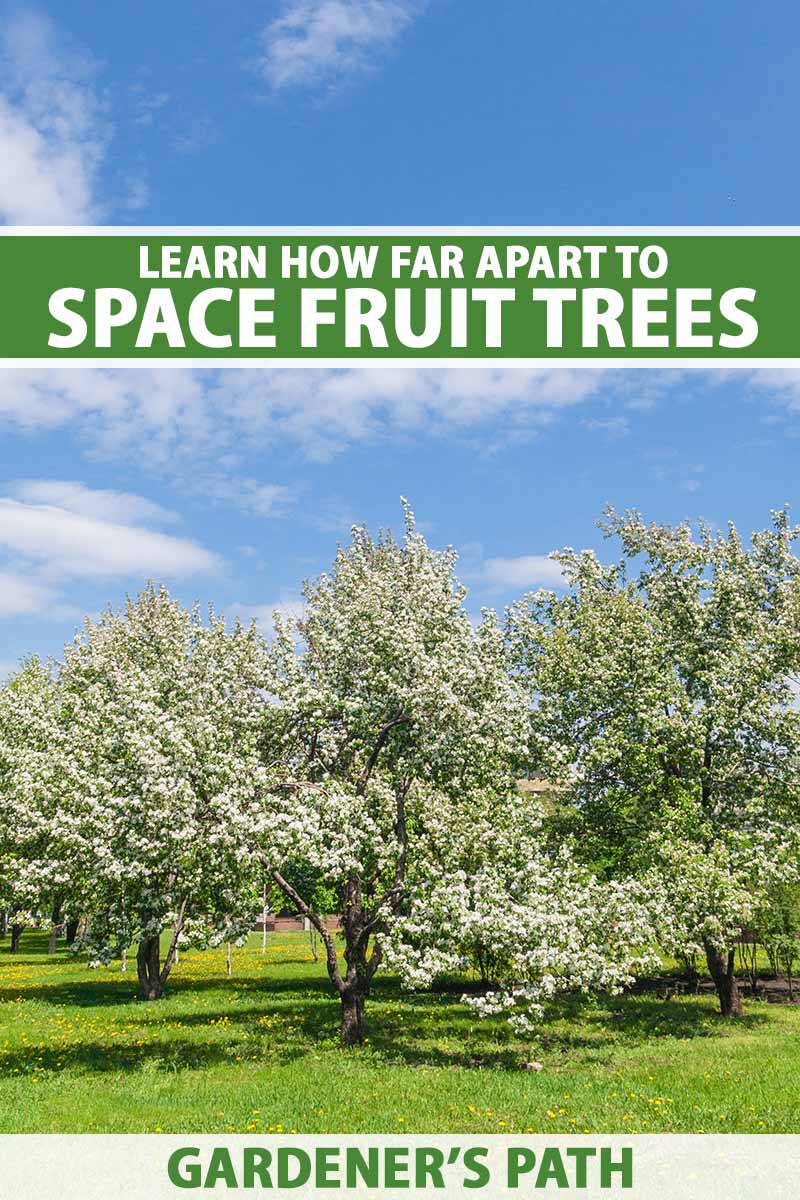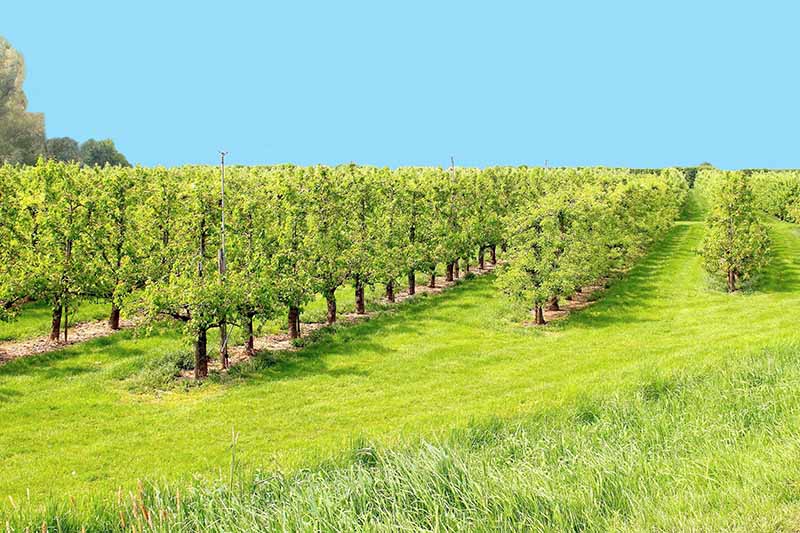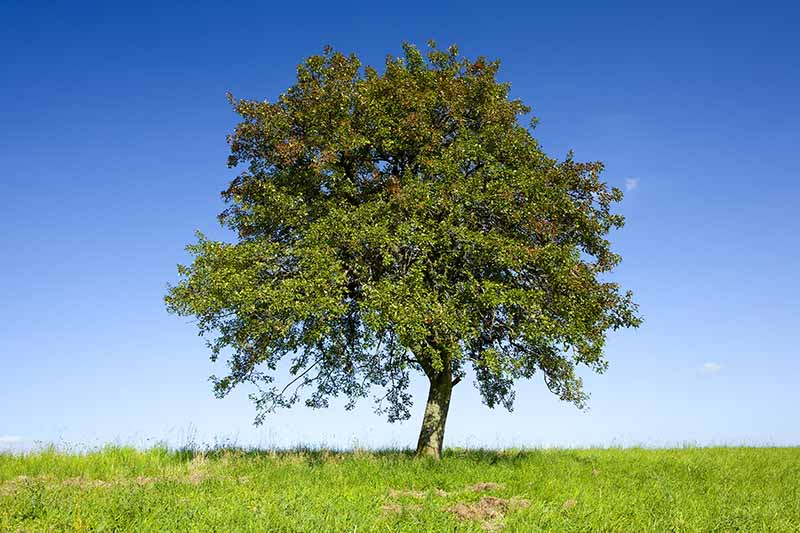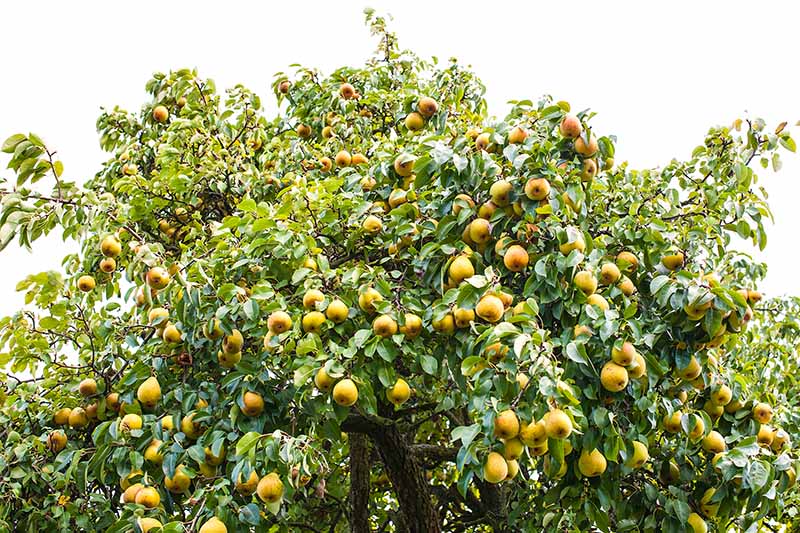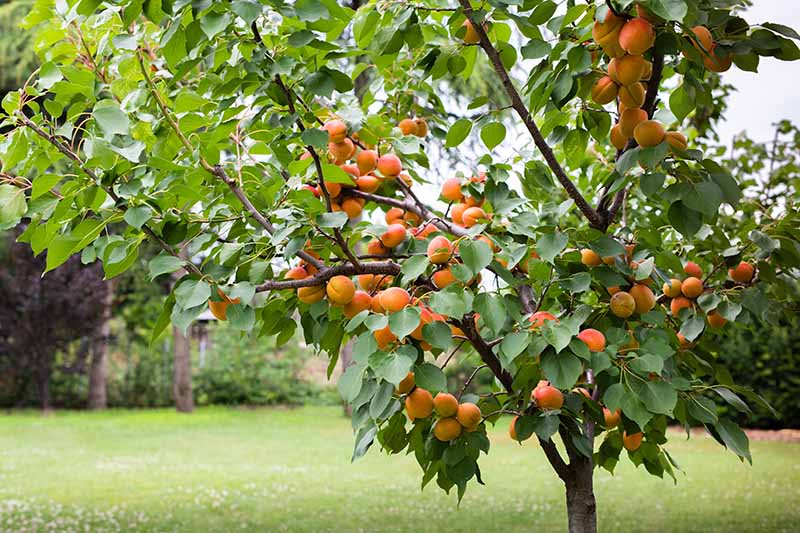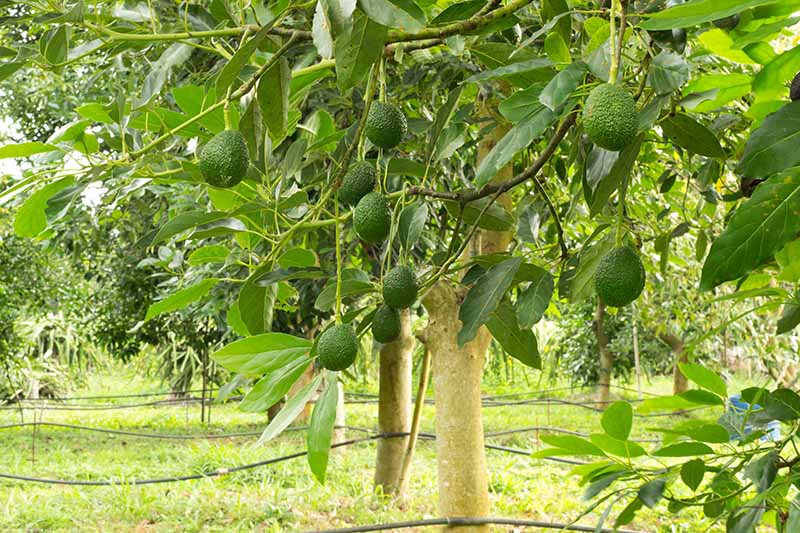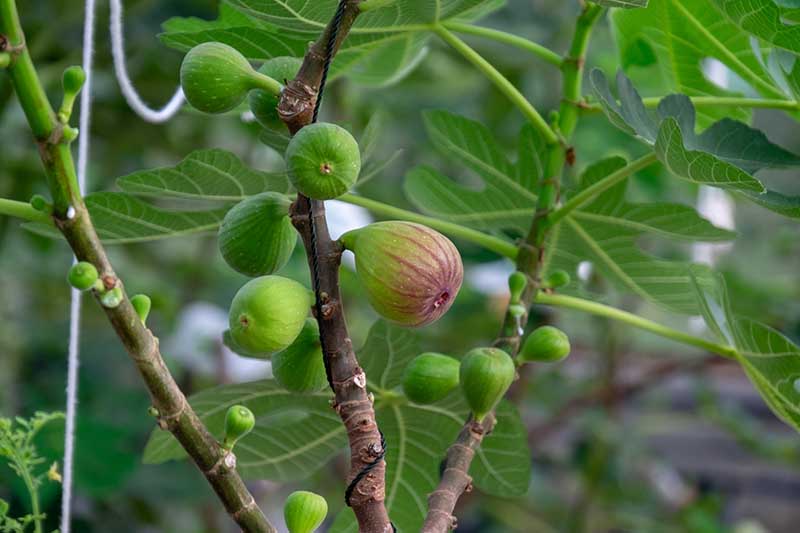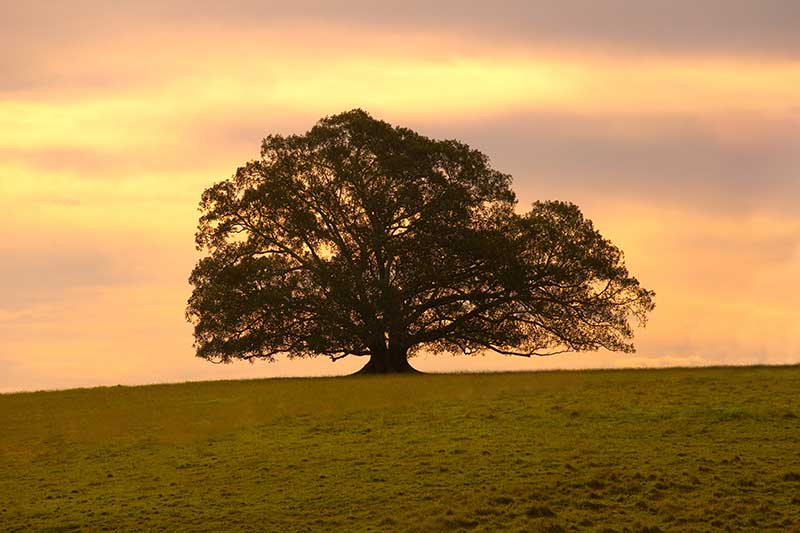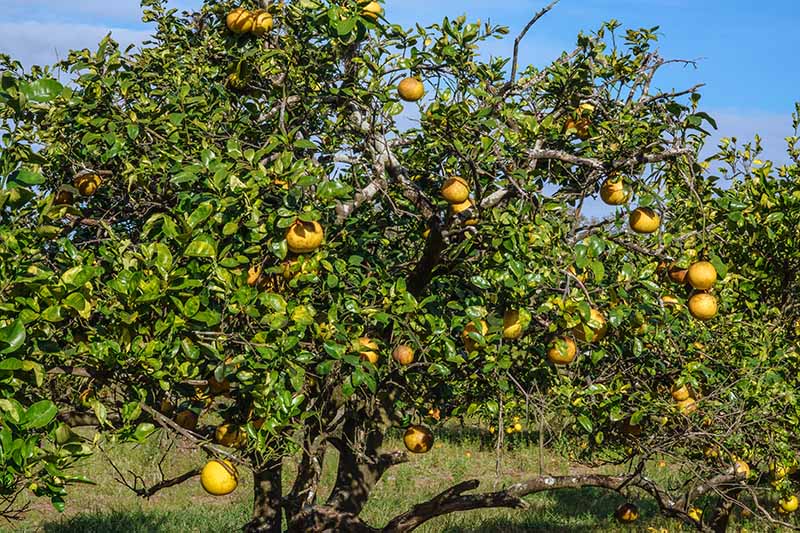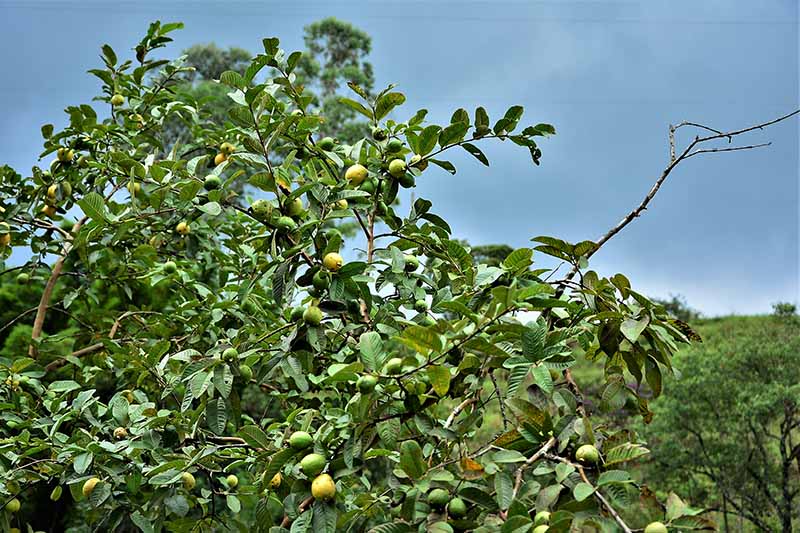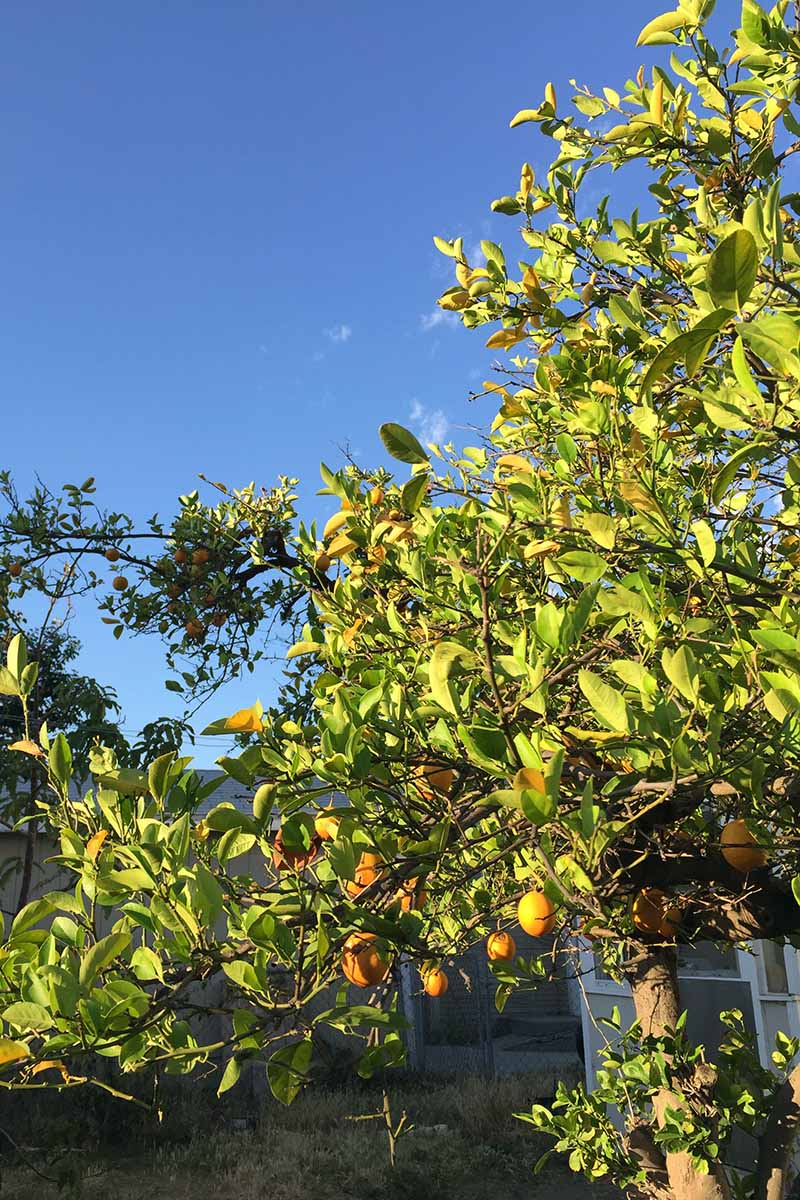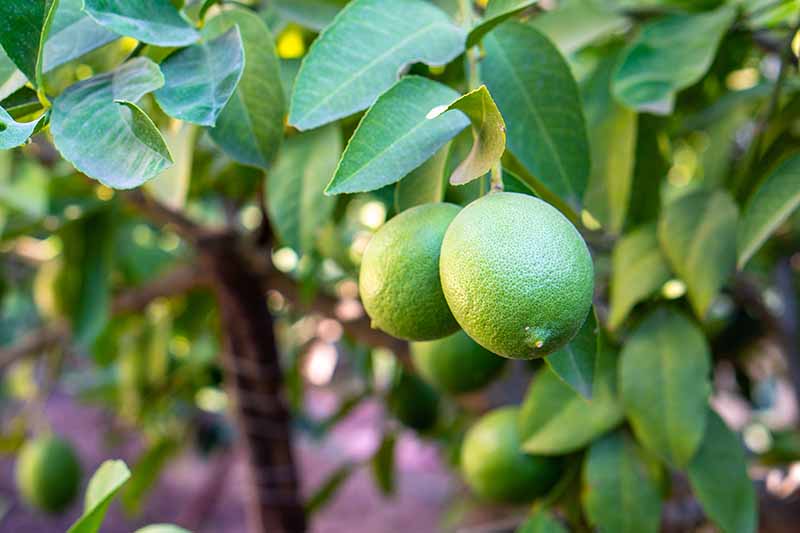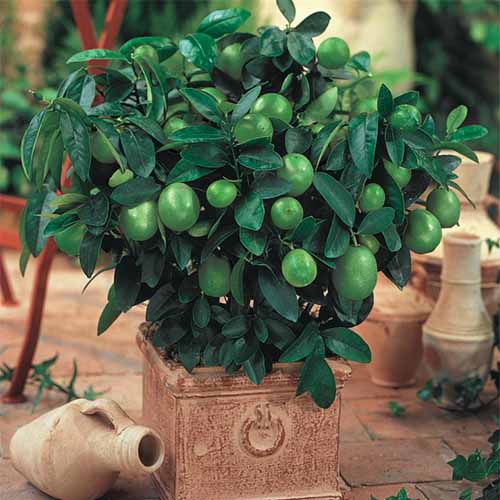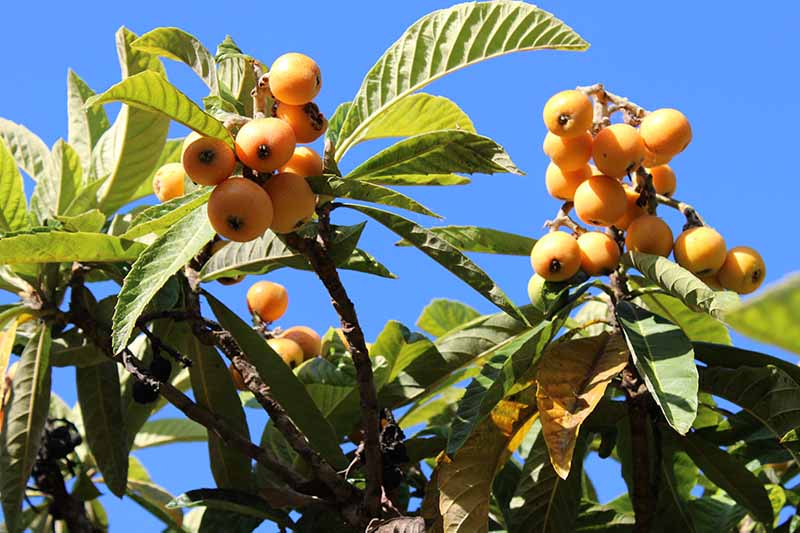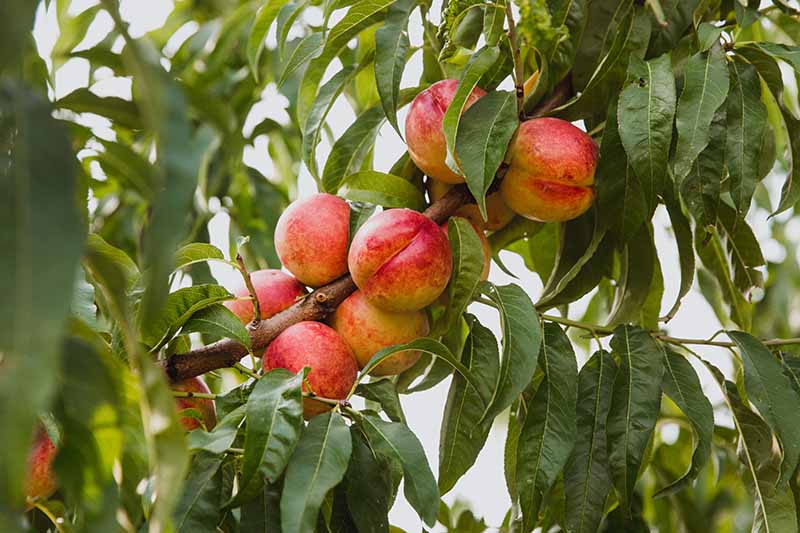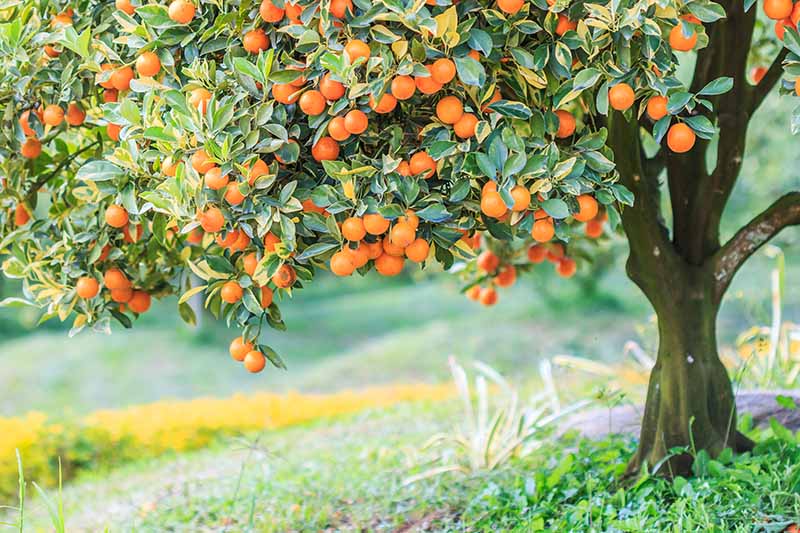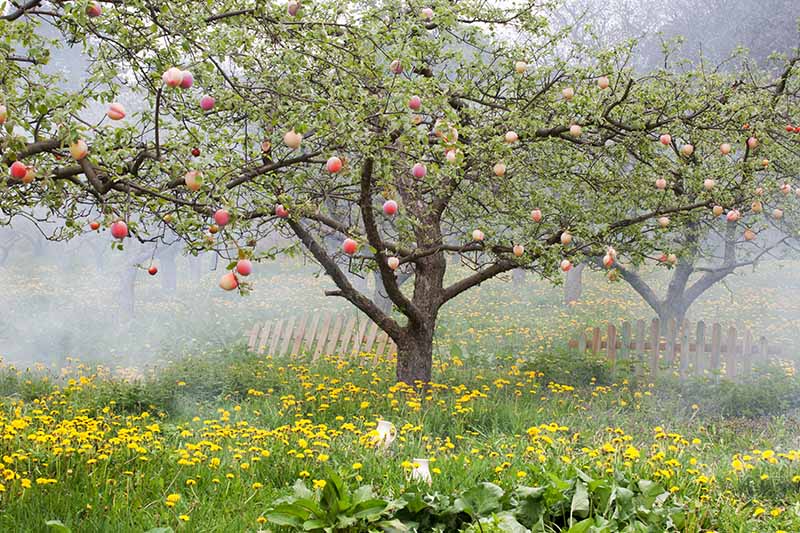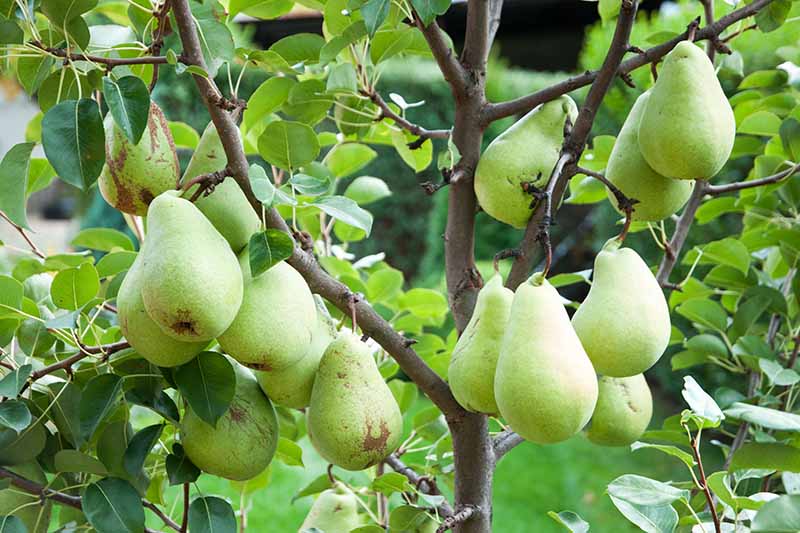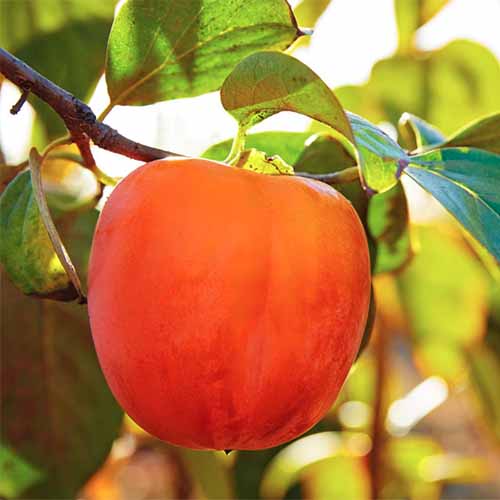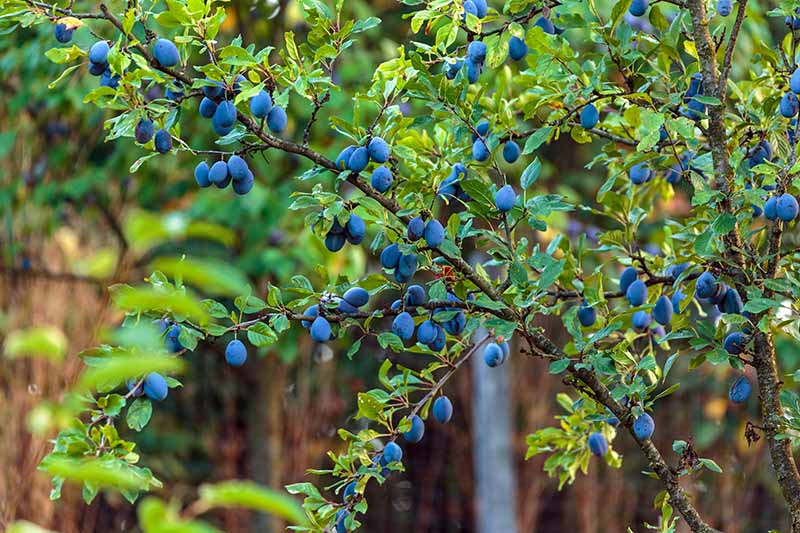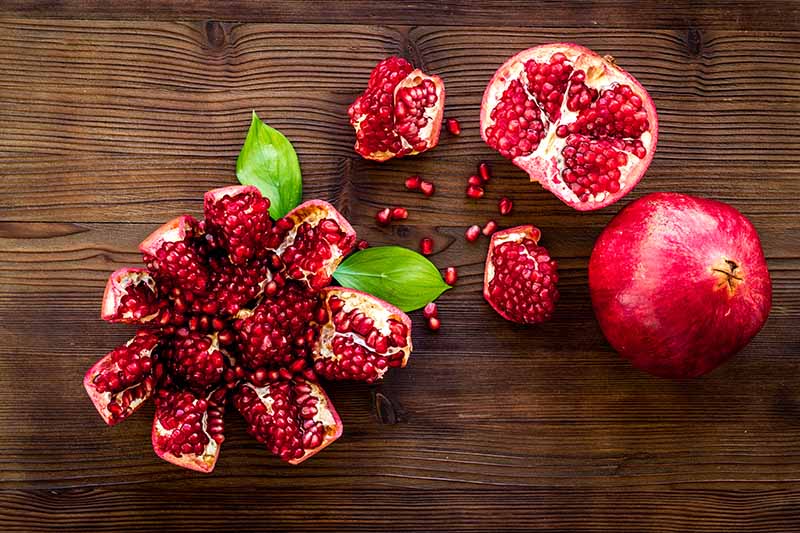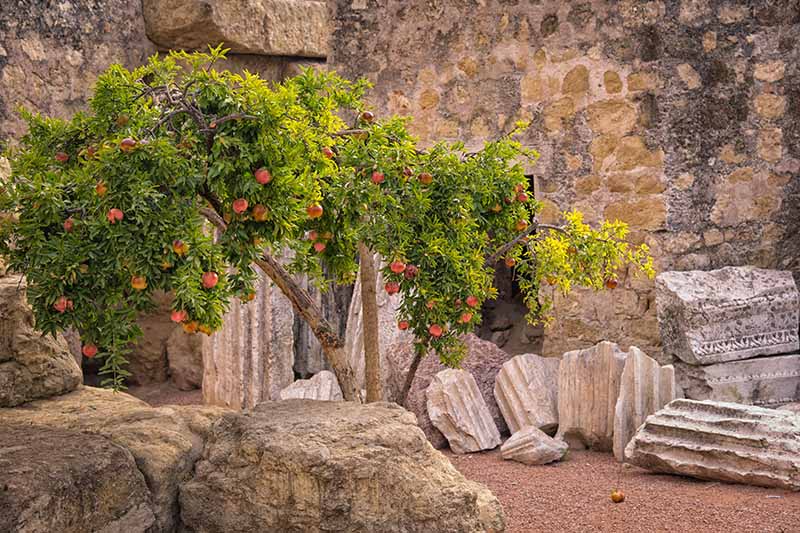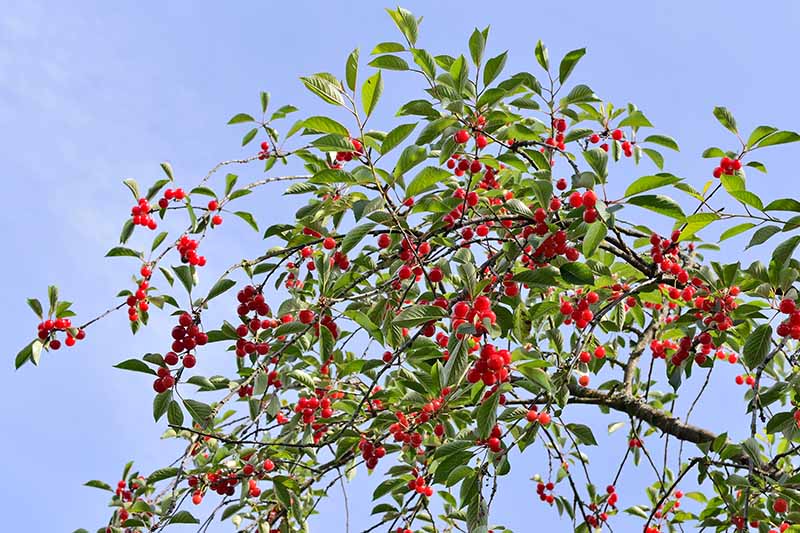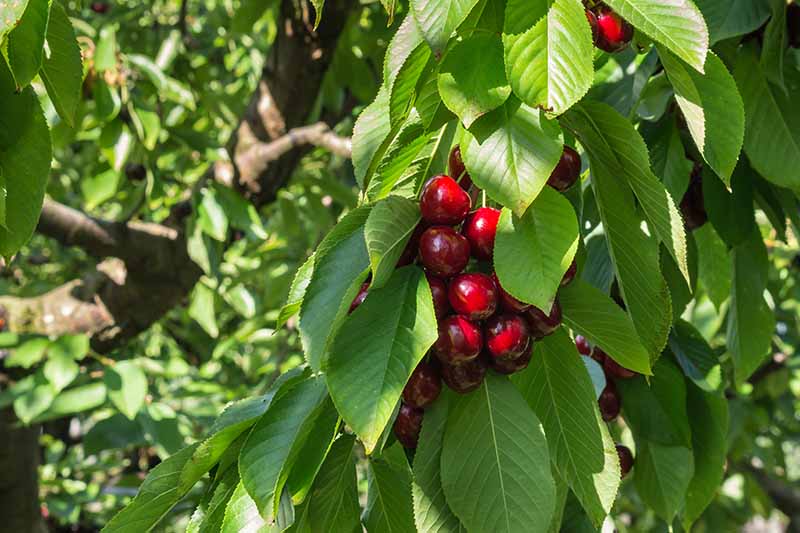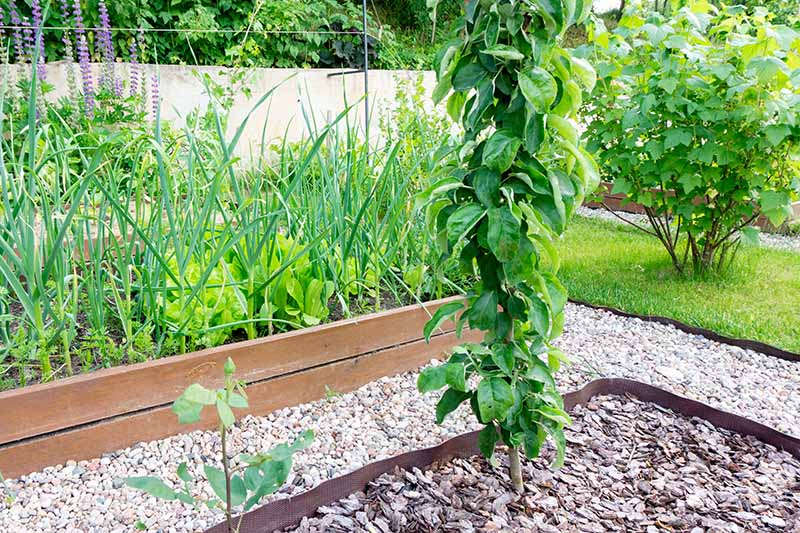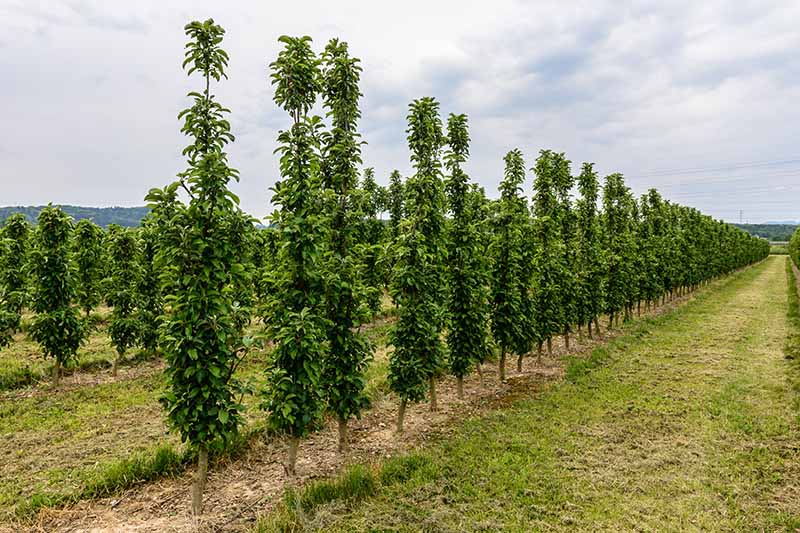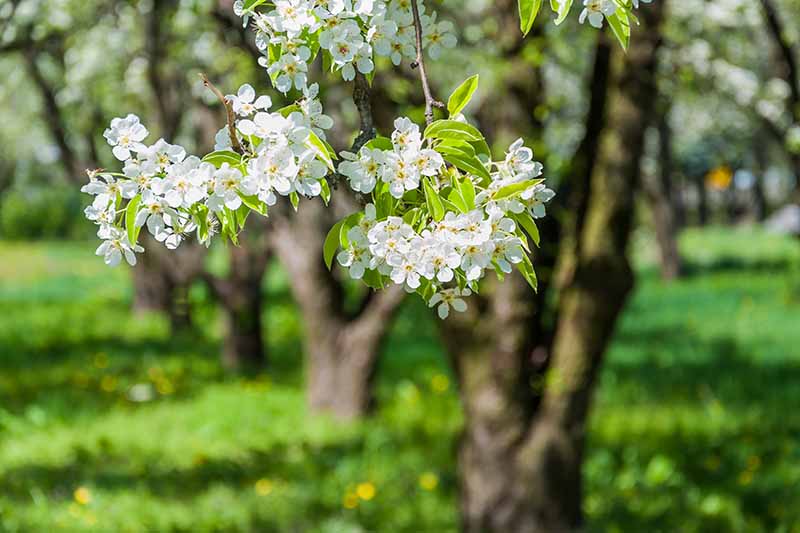But you might be wondering where exactly in your yard to put your fruit trees for optimal growth. How far apart should you plant them? We link to vendors to help you find relevant products. If you buy from one of our links, we may earn a commission. Here’s everything we’ll dive into:
Why Does Spacing Matter?
You’ve probably seen images of fruit trees packed together in commercial orchards. Maybe you’re thinking that you can get away with something similar. The more trees the better, right? Not so much. Commercial fruit growers meticulously plan their orchards for maximum output and minimum risk of disease, often finding a balance between the two. Put simply, the professionals typically have entirely different tools for cultivating mass amounts of fruit trees that the average gardener doesn’t need. Backyard gardeners have to focus on making sure there’s some elbow room available between trees. The measurements we’ll talk about in this article take into account the shade cast by the tree canopy, which affects how much light the neighboring trees and plants receive. It’s also helpful to think of these numbers as being slightly flexible. Some trees grow taller than the top end of their expected mature height range, especially if they’re growing in ideal conditions in a region with a long growing season. Others might never grow as tall as you expected them to. It’s easier in the long run to plant your fruit trees farther apart than you need to, rather than placing them too close together. The bees and other pollinators will find their way, as long as trees that require pollination are within 100 feet of each other. But if you plant them closer rather than farther apart, and the orchard ends up looking crowded a few years down the road, regular pruning can help to keep it healthy. Appropriate spacing also helps to ensure that each fruit tree gets the nutrients it needs from the soil. Root systems stretch out to one and a half to three times the height of a tree. It’s okay for the roots to tangle, but giving them at least the mature canopy’s diameter of room to grow can help them to access the appropriate amounts of nutrition and water. In addition, appropriate spacing:
Reduces overcrowding, which can restrict airflow and lead to increased risk of disease.Makes picking fruit easier.Allows each tree to grow and spread to its full, mature size.Helps ensure easy cross-pollination for the trees that need it.
Before we start, it’s important to note that with many types of fruit trees, you must plant at least two different varieties within the same species that bloom simultaneously to promote cross-pollination. The bloom timing is crucial, hence the dramatic italics: if you grow two different varieties of apple but one blooms at the beginning of the summer and the other blooms a month later, you won’t get fruit. Do your research first to determine which varieties you want to plant together, to ensure a sweet crop of fruit. For best results, space your trees the recommended distance apart. Note that when we say to space trees 20 feet apart, it means 20 feet on all sides of the tree.These distances are the minimum required for optimal pollination; you can spread them farther out from each other if you desire, especially if you’re growing a self-fruitful tree. Any closer and they could become crowded, any farther and pollination may be negatively impacted in some cases. Get out that tape measure and let’s get started!
Fruit Tree Spacing Guidelines
We’ll include spacing guidelines for standard, semi-dwarf, and dwarf varieties when available. Spacing recommendations are for healthy growth based on mature size and other factors, including pollination. Unless you have lots of space in your yard, we recommend planting dwarf and semi-dwarf varieties, especially if you want to plant more than three to five trees. Officially, an orchard is any group of five or more fruit trees. Keep in mind that many types of fruit trees are grown by grafting a scion, or the shoot system of a tree variety known for its fruit, to a rootstock that helps determine tree size, along with cold hardiness and disease resistance. Rootstocks have… interesting, often obscure names. This is in large part because they are based on nursery test trials, and are not typically available on their own for commercial sale. Take these apple rootstocks, for example. Common dwarf rootstocks include ‘Bud 9,’ ‘G.935,’ and ‘EMLA 9.’ Popular semi-dwarf rootstocks are ‘EMLA 26,’ ‘G.202,’ and ‘EMLA 7.’ ‘Bud 118’ and ‘EMLA 111’ are typical, standard rootstocks. EMLA varieties are named for selections from the East Malling and Long Ashton research stations in England, while the Budagovsky or Bud series was developed in Russia. G represents the Geneva rootstock series developed at Cornell University. Apple scions are normally grafted onto apple rootstock, but other species in the Rosaceae family can often work together. For example, peach scions can be grafted onto plum rootstock, and the resulting fruit will be a peach.
Apple
Sing it with me, now: A is for… a Malus domestica! (I have too many kid songs stuck in my head these days. My apologies!) Lest I digress, mature, full-sized M. domestica can grow up to a height of 20 to 25 feet with a similar spread. And I must say, I’m quite excited for my three young M. domestica specimens to get that big! Plant apple trees 20 to 25 feet apart from one another. While some cultivars are self-fruitful, most require cross-pollination between two different varieties that bloom at the same time. Make it easy for the bees who help to give you those delicious, crisp apples and space them no farther than 100 feet apart. Semi-dwarf trees grow to between 12 and 15 feet tall and wide, so give them 15 feet of space between each tree. Dwarf apple trees generally grow to between eight and 10 feet tall with a similar spread. They’re happy to have about 10 feet separating them from surrounding apples, buildings, and fences. It’s alright to plant apples and other fruit trees in the Rosaceae family within 10 feet of structures, because their roots are not invasive. You may want to consider how much shade the structures cast, however, as well as how much shade the apple will give surrounding plants.
Quick Spacing Reference:
Dwarf apples: 10’Semi-dwarf apples: 15’Standard apples: 20 to 25’
Learn more about growing apples in our guide. ‘Pink Lady’ Four- to five-foot-tall ‘Pink Lady’ trees in three-gallon containers are available from Nature Hills Nursery. Looking for the perfect pollinator for your ‘Pink Lady?’ Plant a ‘Honeycrisp’ nearby. Hardy in Zones 3 through 8 and blooming in mid to late spring, ‘Honeycrisp’ is a perfect pairing for your ‘Pink Lady.’ You’ll find that its red and yellow freckled skin and sweet, juicy crunch are utterly irresistible. ‘Honeycrisp’ Grab your four- to five-foot-tall ‘Honeycrisp’ in a three-gallon container from Nature Hills Nursery.
Apricot
Full-size apricot (Prunus armeniaca) trees can grow 20 to 25 feet tall and wide, so it’s best to give them 20 to 25 feet of space between each plant. Apricots are self-fruitful, meaning you only need one tree in order to get a harvest. Cross-pollination between two different cultivars that bloom at the same time can improve yields, however, so why not plant more than one? While dwarf apricot varieties weren’t available until a few years ago, you can now buy dwarf varieties like ‘Garden Annie,’ which grow to between eight to 10 feet tall and wide. Provide eight to 10 feet of space between each plant. One of my favorite apricot varieties is ‘Autumn Glo,’ which blooms in March, has firm, sweet flesh, and doesn’t bruise easily.
Quick Spacing Reference:
Dwarf apricots: 8 to 10’Standard apricots: 20 to 25’
Learn more about growing apricot trees here. ‘Autumn Glo’ Growing just 12 to 15 feet tall and wide, these are the perfect apricots for your warm summer garden. Three-gallon containers are available from Nature Hills Nursery. ‘Chinese’ is an ideal pairing for ‘Autumn Glo’ because it also blooms in early spring. Remember, you don’t need to plant two varieties with similar bloom times next to each other, but yields may improve if you do. ‘Chinese’ With its aromatic, sweet, mild fruits, ‘Chinese’ is hardy in Zones 5 through 9, and grows 15 to 20 feet tall and wide. You can find plants available from Nature Hills Nursery. And for more suggested varieties, see our roundup of the best cold hardy apricots to grow.
Avocado
Avocados from the store taste nice, but avocados right off the tree are heavenly. If you want to grow rich, creamy, nutritious avocados (Persea americana), be sure to set aside enough space in your garden. These can grow up to 30 feet tall and wide, or even a little bit bigger in ideal conditions. Space them 30 feet apart for best results, or buy a dwarf variety, which grows just eight to 10 feet tall and wide. Give these about 10 feet of space. Be aware that avocados have a shallow, vigorous root system that can uproot nearby plants and damage building foundations. Since you do need two different cultivars – one “type A” and one “type B” – in order to ensure that pollination occurs, you might want to choose dwarf varieties if you have a small or medium yard. Favorite varieties include ‘Fuerte,’ a type B with somewhat thin skin and robust flavor; ‘Hass,’ a type A known for its large and flavorful fruit; and ‘Wurtz’ (also known as ‘Little Cado,’ thanks to its dwarf stature), the popular miniature avocado tree. You can find some of the best cultivars for cooler growing zones in our roundup.
Quick Spacing Reference:
Dwarf avocados: 10’Standard avocados: 30’
Learn how to grow avocados in our guide.
Fig
There’s a story from my partner’s side of the family that I love. His great-grandparents immigrated to the United States from Italy, and when they moved they brought a common fig (Ficus carica) cutting with them and planted the rooted cutting in their new home. My partner’s grandpa had to move out of this home eventually and sold it to someone else – but before he left, he took a cutting from the fig. He planted that one in Highland, California, and my partner grew up eating fresh figs from the tree it became. As figs do, it grew tall – almost 30 feet tall with a similar spread, which is right on target for a fig. But if you’re lucky, yours will grow so old that it’ll spread up to 50 feet wide. Fig roots can be aggressively invasive, though, so make sure you plant them at least 50 feet away from any walls or buildings. Moreton Bay figs (F. macrophylla), a non-edible variety, can even reach 200 feet in height and width in ideal conditions, so you probably shouldn’t plant one of those unless you have boatloads of space! Some figs are pollinated by small wasps in the Agaonidae family, though most common types grown for eating are self-fruitful and don’t require a wasp (or a second tree) for pollination. This is a good thing, since you have to give each standard fig at least 50 feet of space on all sides! Dwarf varieties grow from six to 10 feet tall with a spread of just five to eight feet, so it’s much easier to grow several in the same yard. Space each dwarf fig eight feet apart. ‘Brown Turkey’ is a popular variety that doesn’t require wasp pollination, as is ,’ ‘Celeste,’ ‘Chicago Hardy,’ which also – as its name suggests – grows well in colder areas. Check out our roundup to learn more about fig varieties.
Quick Spacing Reference:
Dwarf figs: 8’Standard figs: 50’
You can read more about how to grow figs in our guide.
Grapefruit
Do you love scooping sweet, tangy, bright red grapefruit flesh out from its rind and spooning it into your eagerly awaiting mouth? So do I. If you live in a warm and sunny area, you’re in luck: you may have the opportunity to grow these fruits in your own backyard. Grapefruits (Citrus × paradisi) are self-fruitful citrus trees that grow 15 to 30 feet tall and wide, depending on the variety. Give these 15 to 30 feet of space between each, and the same amount of space away from buildings. Semi-dwarf cultivars grow eight to 12 feet tall and wide, so give them 12 feet of space on all sides. Want to grow a small tree that produces fruit with yellow rinds and sweet-tart red flesh?
Quick Spacing Reference:
Semi-dwarf grapefruits: 12’Standard grapefruits: 15 to 30’
Learn more in our guide to growing dwarf citrus. ‘Rio Red’ You can find a four-by-four-by-nine-inch container with a one- to two-foot plant available from Nature Hills Nursery.
Guava
I’m Cuban, and if there’s a fruit tree that screams “Cuba,” it’s the guava (Psidium guajava). I grew up getting boxes of treats in the mail from my Cuban grandparents, and there was always pasta de guayaba (guava paste) in there. I loved cutting a slice of the paste, adding a piece of cream cheese, and sandwiching it between two crackers. I’m not the only one, either – this is a popular treat in many Latin American countries! If you’re lucky enough to live in a growing zone that supports guavas, reserve a good bit of space in your yard. This tropical plant can grow 15 to 25 feet tall and wide. Give each one at least 25 feet of space on every side. Dwarf varieties are extra short, though, so feel free to plant more than one. Dwarf guavas reach just four to six feet tall and wide, meaning you only need to allot six feet of space between each guava. Some guavas are self-fruitful, but it’s best to plant two different cultivars for a good-sized harvest.
Quick Spacing Reference:
Dwarf guavas: 6’Standard guavas: 25’
Popular cultivars include ‘Crystal,’ an extra-sweet and mostly seedless cultivar, and ‘Patillo,’ a variety with sweet, bright pink flesh.
Lemon
Back when I lived in southern California, one of my favorite things about the house I rented was the old lemon tree growing in the backyard. Whenever I had a hankering for lemon bars, I’d climb up into the branches and pick a few ripe fruits. I’ve never had better lemon bars – not before I lived at that house, and not since I moved away. Lemons (Citrus x limon) grow 10 to 25 feet tall and 15 to 20 feet wide, so give them at least 20 feet of space in the garden. These self-fruitful citrus trees don’t require a nearby lemon in order to produce fruit. Mine happily produced more fruit than I could use, and it was the only lemon around. Although, I did have a massive grapefruit tree growing on the other side of the garage. I know, I know, I’m just bragging now. It was a pretty dreamy setup! If you’d rather plant a smaller citrus, dwarf lemons grow eight to 10 feet tall and wide, so you can fit more of them in a smaller yard or garden. Allocate 10 feet of space between each tree. But, I will say, there is nothing quite like climbing into your very own, standard-sized lemon and plucking bright fruits off the branches.
Quick Spacing Reference:
Dwarf lemons: 10’Standard lemons: 20’
‘Eureka,’ which bears a fresh, powerful lemon flavor and few seeds, and ‘Meyer,’ a small, thin-skinned, extra-sweet lemon that makes dreamy lemon bars, are two popular varieties to grow at home.
Lime
Is there anything tastier than homemade key lime pie made from limes you grew in your yard? Perhaps not. If you want to add to your little citrus grove with a lime tree, here’s what you need to know about spacing. Limes (Citrus x aurantifolia) grow 15 to 20 feet high with a spread of 15 feet, so give your plant 15 feet of space between it and another tree. Like most citrus trees, limes are self-fruitful. Dwarf limes grow six to 10 feet tall and about six or seven feet wide. Give each one at least seven feet of space to grow and stretch.
Quick Spacing Reference:
Dwarf limes: 7’Standard limes: 15’
Loquat
Do you adore the sweet, tangy flavor of loquats? Dwarf Key Lime Tree This dwarf key lime tree from Gurney’s, available at the Home Depot, comes in a four-inch pot, is hardy in Zones 9 and 10, and is ideal for small growing spaces. If you dream of growing your own, you’ll want to set aside a space that allows for 25 feet of growing room, as the loquat (Eriobotrya japonica) grows 15 to 30 feet tall and 15 to 25 feet wide. Dwarf loquats can grow anywhere between six and 15 feet tall and wide, depending on the variety. Give each tree at least 10 to 15 feet to stay on the safe side. While most cultivars are self-fertile, cross-pollination with other varieties that bloom at the same time can increase production. ‘Tanaka’ and ‘Advance’ are two varieties that bloom together and help each other bear lots of fruit.
Quick Spacing Reference:
Dwarf loquats: 10 to 15’Standard loquats: 25’
Take a deep dive into the care of these delicious fruits by reading our guide to growing loquats.
Mango
The mighty mango (Mangifera indica) can grow over 100 feet tall and 50 feet wide, but boy, is the large, orange fruit tasty. If you’re lucky enough to live on an enormous property, you can plant a standard mango in your yard and bring all your friends over to see it. Just make sure you plant it at least 50 feet away from, well, everything. The roots go deep and can mess with building foundations if they’re planted too close to homes and other structures. Mangoes are self-fruitful, so you won’t need to plant two of the whoppers in order to get fruit. If you live in a smaller space, don’t fret! Dwarf mangoes grow just 10 to 20 feet tall and wide, depending on the cultivar, meaning almost anyone can give mango-growing a try. While they’re only suited to outdoor growing in Zones 9 through 11, they can be grown in containers indoors in Zones 4 through 8 if you have the space. Give each dwarf mango 10 to 20 feet of space on all sides.
Quick Spacing Reference:
Dwarf mangoes: 10 to 20’Standard mangoes: 50’
The ‘Carabao’ mango is renowned worldwide for its sweetness. ‘Honey Kiss’ is a compact, container-friendly cultivar that you can grow indoors all year long.
Nectarine
Ah, nectarines. Do you like to enjoy them when they’re crunchy or soft? I’m a diehard fan of crunchy nectarines myself, and no one can make me eat one that’s overly ripe. Regardless of which way you adore eating these delicious stone fruits (Prunus persica var. nucipersica), growing them in your own yard lets you decide whether to pick them early, or let them continue to ripen on the branch or your counter until they’re soft and juicy. Standard nectarines grow 18 to 25 feet tall and wide, so give each one 25 feet of space on all sides. Semi-dwarf nectarines grow 12 to 18 feet tall and need 18 feet of space on all sides, and dwarf varieties grow five to eight feet tall. Give the smallest nectarines eight feet of space.
Quick Spacing Reference:
Dwarf nectarines: 8’Semi-dwarf nectarines: 18’Standard nectarines: 25’
With its sweet white flesh and striking flavor, ‘Arctic Glo’ is a popular nectarine to grow at home. ‘Summer Grand’ produces large yellow fruits that are also known for their sweet flavor.
Orange
If you’ve ever driven past an orange grove, you know that oranges (Citrus x sinensis) can grow quite tall. The mature height of an orange is 20 to 30 feet, with a spread of 20 feet. Give oranges at least 20 feet of space in the garden. Like lemons, they are self-fruitful, so you only need to plant one. Or, plant an orange and a lemon next to each other and enjoy homegrown lemon bars for dessert and fresh orange juice for breakfast. Compact or dwarf varieties grow eight to 10 feet tall with a spread of just three to five feet, so space them at least five feet apart for best results.
Quick Spacing Reference:
Dwarf oranges: 5’Standard oranges: 20’
Peach
Sweet, tart peaches (Prunus persica) are usually self-fruitful, so you probably only need to plant one in order to get fruit. ‘Valencia’ You can find a three-gallon container with a live plant that’ll grow eight to 10 feet tall and wide from Nature Hills Nursery. ‘Valencia’ is hardy in Zones 9 and 10 if you grow it in the ground, or Zones 6 through 10 if you opt to plant it in a container and move it indoors during the winter. But if you limit yourself to just one tree, you may only get a small crop of peaches. Why not plant more? Pick up two trees of different varieties that bloom at the same time and you’ll harvest a bigger bounty of peaches. Full-sized peach trees grow up to 20 feet tall and wide, so you’ll need to plant them 20 feet apart. Dwarf peaches grow eight to 10 feet tall with a spread of 10 feet, so allocate 10 feet of space between each tree.
Quick Spacing Reference:
Dwarf peaches: 10’Standard peaches: 20’
Find out everything you need to know about growing peaches in our guide. ‘Babcock’ has firm, white flesh perfect for canning, is hardy in Zones 6 through 10, and grows 12 to 15 feet tall and wide. ‘Babcock’ Find a three-gallon container with a four- to five-foot tree from Nature Hills Nursery. ‘Hale Haven’ is a juicy yellow peach that shines in pies. Is hardy in Zones 5 through 8, and grows 12 to 15 feet tall and wide. ‘Hale Haven’ Grab your three-gallon container from Nature Hills Nursery. ‘Harken’ is that classic, fuzzy, soft peach that will make juice dribble delightfully down your chin. ‘Harken’ Hardy in Zones 5 through 9, ‘Harken’ grows 15 to 25 feet tall and wide, and is available in a three-gallon container from Nature Hills Nursery.
Pear
Like apples, Asian and European pears typically require cross-pollination between varieties that bloom at the same time. But pears (Pyrus spp.) don’t grow as tall as apples. A mature, full-size pear will reach up to 20 feet high and wide. Space your pear trees 20 feet apart. For semi-dwarf varieties, which can grow up to 12 to 15 feet tall and 10 feet wide, provide 12 feet of space between each tree. Dwarf varieties grow eight to 10 feet tall and spread just seven or eight feet, so they need eight feet of space between each. My favorite pear cultivars include ‘Anjou,’ a lightly sweet, firm-fleshed cultivar, and ‘Bartlett,’ a super-sweet, soft cultivar that cross-pollinates with ‘Anjou.’
Quick Spacing Reference:
Dwarf pears: 8’Semi-dwarf pears: 12’Standard pears: 20’
In our guide to growing pears, you’ll learn all the ins and outs of care.
Persimmon
If you want to grow persimmons (Diospyros spp.), save a space that’s 25 feet diameter where you want your tree to grow, because these beauties grow 20 to 25 feet wide – and 30 to 60 feet tall! If you’d rather plant a smaller persimmon, dwarf types grow just eight to 10 feet tall and wide, so you can plant several in your yard just 10 feet apart and harvest those soft, spiced and sweet fruits every fall. Learn more about different persimmon types in our roundup. ‘Hachiya‘ ‘Hachiya‘ is a popular self-fruitful cultivar that grows in Zones 8 and 9, boast bright-orange skin and flesh, and is available at the Home Depot in one-gallon containers. ‘Rosseyanka’ is a small, sweet hybrid persimmon. You only need to plant one tree as ‘Rosseyanka’ does not require another tree for pollination.
Quick Spacing Reference:
Dwarf persimmons: 10’Standard persimmons: 25’
You can learn more about how to grow Asian persimmons in our guide. And you can learn more about American types here.
Plum
These trees (Prunus domesticus) are for the most part not self-fruitful, which means you must plant at least one additional plum tree of a different variety nearby after you plant the first one. Make sure your selected varieties bloom at the same time, too! Plums grow 20 to 25 feet tall with a spread of 15 to 20 feet, so provide each plant with 20 feet of space on all sides. Dwarf plums grow eight to 10 feet tall and wide. Allot 10 feet of space between these.
Quick Spacing Reference:
Dwarf plums: 10’Standard plums: 20’
Pomegranate
The first time I ever saw a pomegranate (Punica granatum), I was completely in awe of the dozens of red jewels inside the fruit. ‘Blue Damson’ ‘Blue Damson’ saplings in three-gallon containers are available from Nature Hills Nursery. Or try ‘Hollywood,’ a cultivar with deep red skin and flesh that fruits well on its own but produces much more when paired with ‘Howard Miracle.’ ‘Hollywood’ ‘Hollywood’ grows 10 to 15 feet tall and wide and thrives in Zones 5 through 9. Find ‘Hollywood’ in a three-gallon container from Nature Hills Nursery. ‘Howard Miracle’ ‘Howard Miracle,’ which grows 10-15 feet tall and wide and is suited to Zones 5-9, is also available from Nature Hills Nursery in three-gallon containers. Even better, the “jewels,” which are called “arils,” taste a bit like a tart cherry with a hint of sugar. Pomegranate trees are perfect for those with smaller yards and growing spaces because most reach just 12 to 15 feet tall and wide. But some can grow 20 or even 30 feet tall and wide, depending on the variety and location. Give each pomegranate 15 to 30 feet of space on all sides, depending on the variety that you choose. Dwarf pomegranates vary in size from very small types that only take up three to six feet of space. Others may grow up to 10 feet tall and wide. Make sure you check the expected mature size of the dwarf variety you’ve selected and space it six to 10 feet apart, depending on its mature width. Pomegranates are self-fruitful, but they produce more fruit when paired with another variety that blooms at the same time.
Quick Spacing Reference:
Dwarf pomegranates: 6 to 10’Standard pomegranates: 15 to 35’
Sour Cherry
Unlike its sister, the sweet cherry, the sour cherry (P. cerasus) is self-fruitful. But as is the case for many fruits, if you plant another sour cherry tree of another type nearby, your yield will increase. So why not get at least two? ‘Purple Heart’ Plants in one-gallon containers are available from Nature Hills Nursery. ‘Red Silk’ is another nice option that features a pinkish-orange rind and matching arils, and grows 12 to 18 feet tall and wide. ‘Red Silk’ Hardy in Zones 7 through 10, ‘Red Silk’ grows well in the ground or in large containers. One-gallon containers are available from Nature Hills Nursery. Read more about growing pomegranates here. ‘Early Richmond,’ ‘Meteor,’ and ‘Montmorency’ – which makes some of the best cherry pies around – are three excellent tart cherry tree varieties. ‘Early Richmond’ blooms in April and produces cherries a couple months later for a mid-summer harvest. ‘Meteor,’ a dwarf, and ‘Montmorency,’ a cold-hardy hybrid, bloom around mid- to late May. Sour cherry trees don’t grow quite as tall as sweet cherries. Standard sour cherries can reach up to 20 feet tall and wide, so make sure to space them 20 feet apart. Dwarf varieties grow up to eight feet tall with a spread of 10 feet, and will need to be spaced 10 feet apart.
Quick Spacing Reference:
Dwarf sour cherries: 10’Standard sour cherries: 20’
Learn more about how to grow cherries in our guide.
Sweet Cherry
Unlike its sour counterpart, the sweet cherry tree (Prunus avium) is not self-fruitful, so you’ll need to plant at least two varieties of sweet cherry in order to get a crop. Commonly grown varieties include ‘Bing’ – which can cross-pollinate with the sour ‘Montmorency’ cherry – ’ as well as ‘Rainier’ and ‘Stella,’ which can pollinate each other. Sweet cherries grow up to a whopping 35 feet tall with a spread of about 25 feet, so they require plenty of space in the garden. Plan for at least 25 feet between each cherry. Semi-dwarf sweet cherries grow 15 to 18 feet tall and wide, whereas dwarf sweet cherries top out at 12 to 15 feet tall and wide. Space semi-dwarfs 20 feet apart, and dwarfs 15 feet apart.
Quick Spacing Reference:
Dwarf cherries: 15’Semi-dwarf cherries: 20’Standard cherries: 25’
For more varieties to choose from, check our roundup of recommended cold-hardy cherry trees.
A Note on Space-Saving Varieties
In the spirit of making fruit-growing accessible to those who live in urban spaces, plant breeders have been working to produce narrow, or columnar, versions of many types of fruit trees. They’re a little harder to find and more expensive than standard sizes, and they don’t bear as much fruit. But what does that matter when you can plant them close together, or a tiny plot? Since columnar fruit trees are bred to grow straight up instead of spreading outward, they tend not to grow more than two to four feet wide. This means you can plant them just three or four feet apart! Another way to save space is via espalier-style growing. I recently drove through part of Washington State and saw lots of apple trees that had been pruned and trained to grow laterally on frames. ‘Scarlet Sentinel’ Three- to four-foot trees are available in three-gallon pots from Nature Hills Nursery. It cross-pollinates with ‘Golden Sentinel,’ which grows two to three feet wide and 10 to 12 feet tall, is suited to Zones 4-8, and produces large golden apples. ‘Golden Sentinel’ You can find bare root plants available from Burpee. If you have a small yard, your dream of planting fruit trees can still come true – in a narrow, columnar way. You can also train them to grow flat against walls or lattices. Apples, cherries, peaches, pears, and pomegranates are the trees most often grown in the espalier style. If you’re wondering whether or not you can mix different fruit tree species together, by the way, the answer is yes – as long as you follow all of the requirements for the maximum spacing of the larger tree, as well as other growing requirements. This might mean you end up with two apples, two pears, two sweet cherries, and so on, and your home will be the talk of the town. You might as well set up a roadside stand, you’ll have so much fruit. Have you ever cultivated an orchard, large or small? Let us know in the comments section below! We love to hear from you. And check out these additional guides to help you choose which fruits to grow next:
19 Apple Tree Varieties That’ll Knock Your Socks Off11 of the Best Fruiting Pear Varieties to Grow at Home17 Unusual Fruits and Vegetables for Your Backyard Landscape
